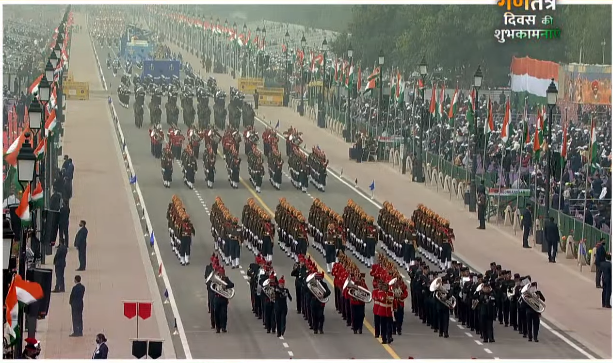
From Kingsway to Rajpath to Kartavya Path, a Delhi road at centre of power for 90 years

The Union government’s proposal to change the name of Delhi’s Rajpath, which runs from Rashtrapati Bhavan to India Gate, to Kartavya Path (Path of Duty), is all set to get the approval during the New Delhi Municipal Council’s (NDMC) special meeting scheduled for Wednesday (September 7).
On September 8, Prime Minister Narendra Modi will inaugurate the central avenue, which will be opened to the public next week after a 20-month gap.
Called Kingsway during British rule, Rajpath hosts major state functions like the Republic Day Parade on January 26 every year and the Beating Retreat ceremony.
Also read: Govt decides to rename Rajpath in Delhi as Kartavyapath
The ceremonial axis
Kingsway was created by the British as a ceremonial boulevard and was designed on the lines of Kingsway in London, which had been opened in 1905 and which was also a custom-built arterial road which had been named in honour of George V’s father, Edward VII. In Delhi, it was named after King George V, who had come to the city for the Delhi Durbar of 1911, where the shifting of the capital from Calcutta (Kolkata) to Delhi was announced.
Opinion: Kartavya Path parades duties-first diktat, U-turns on rights
The new capital was built over the next 20 years and it was in 1931 that it was inaugurated. The central vista of New Delhi, Kingsway, formed the centre of the new capital. Sir Edwin Lutyens, who was given the charge to design and build the capital, conceived of a modern imperial city centered around a “ceremonial axis”, which was the Kingsway.
Lutyens wanted a panoramic view of the city of Delhi from the viceregal palace, which was built on a slight elevation — the Raisina Hill – which afforded unhindered views of Jama Masjid on the east and Purana Quila in front.
There’s an interesting story about how the central vista was planned. It is said that it was Viceroy Lord Hardinge who was responsible for deciding on the precise location of the Viceroy’s residence, and consequently, the ceremonial avenue that led out from it. Lutyens had planned on having the Viceroy’s House look down the avenue that led from it to the back of Jama Masjid. This was abandoned in favour of having the Viceroy’s House sit atop Raisina Hill and Kingsway leading from it to end at Purana Qila. With a view of Jama Masjid to the left and Safdurjung’s Tomb to the right, the view from the house of the Viceroy would thus comprise of all objects of historic interest in the city.
Historian and author Swapna Liddle, in her book Connaught Place And The Making of New Delhi, cites a speech given by Lutyens in 1933 in which he acknowledged Hardinge’s role in this: “His command that one avenue should lead to Purana Qila and another to the Jumma Masjid was the father of the equilateral and hexagonal plan.”
Historian Narayani Gupta in her 1994 article — Kingsway to Rajpath: The democratisation of Lutyens’ Central Vista — describes the vista as it appeared at the time when the British rulers were in office: “In the 1930s and 40s, when the Viceroy was in residence for five months of the year, and the Secretariat and Imperial Record Office were in commission, the Vista was kept free of traffic. After office hours…The parks were used by a few riders and pedestrians, but on the whole it was underused: A Champs-Elysees without people.”
New avatar as Rajpath
Following independence, the road was given its Hindi name, ‘Rajpath’, which was almost a literal translation of Kingsway. The Viceroy’s residence became the Rashtrapati Bhavan, the official residence of the President of India.
The celebration of the Republic Day Parade and the Beating Retreat at Rajpath marked the arrival of India as a sovereign state on the international scene. The parade marches from the Rashtrapati Bhawan along the Rajpath to India Gate and from there to Red Fort.
In 2016, history of sorts was made when the 35th Infantry Regiment of France marched down Rajpath, becoming the first foreign contingent to take part in the parade. Raised in 1604, the regiment Interestingly fought against the British with support from Haider Ali of the erstwhile kingdom of Mysore in 1781.
The Rajpath is flanked by North Block and South Block, leading to Vijay Chowk, a spacious plaza and the site of Beating the Retreat ceremony on January 29 each year, which marks the end of Republic Day celebrations.
The Rajpath, lined with trees and with lawns and water fountains on both sides, ends at India Gate, a war memorial arch in honour of those who died in the First World War and the Second Anglo-Afghan War. It is also India’s memorial of the unknown soldier.
Place to picnic
The Rajpath and area around India Gate became a favourite place for Delhiites to spend some time outdoors. Many flock the lawns for leisure activities like picnics, boating, visiting a children’s park and more. Food stalls, ice cream carts, and vendors selling trinkets had become part of this landscape till 20 months ago when the area was closed to public for the construction of the Central Vista Project by the NDA government.
Also read: The symbolism of statues in Modi’s new India
The area has over the years also become known for holding major protests. A major farmer’s protest under the leadership of Mahendra Singh Tikait was held here in 1989. More recently protests were held during the Nirbhaya rape case and later when the CAA-NRC issue was being debated.
With Rajpath now getting a new name, it will the third chapter in the long history of the central avenue running from Rashtrapati Bhavan to India Gate.


